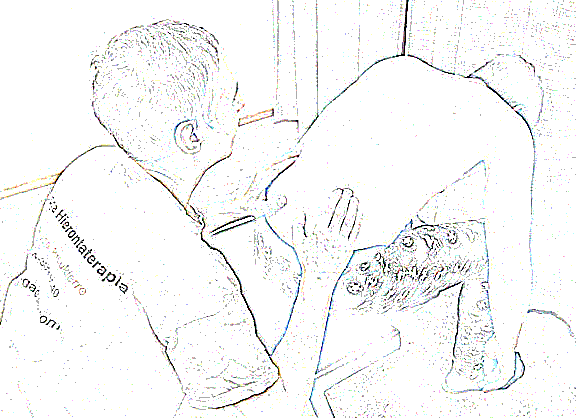Functional Fascial Release (ATSI 3)
What is Functional Fascial Release?
![Re-alignment in gravity [Re-alignment in gravity]](../pictures/realign-in-gravity.gif)
Functional Fascial Release is a method for releasing shortened or stuck fascia (connective tissue). The aim is to make the body move more smoothly and make it easier to maintain good posture. Functional Fascial Release is a collaboration between the client and the therapist. The therapist contacts the tissue to be mobilized with his hands and then asks the client to move in a certain way. During the client’s movement, the therapist stretches or shifts the tissue or possibly loosens it from adhering tissue. Occasionally the movement is passive, i.e. the therapist moves a body part of the client. Compared to fascia treatments in Kalevala bonesetting and osteopathy, the grip is firmer and more intense. Occasionally the treatment may hurt, but only for a short time and the pain should remain bearable. It is very important that the body is not afraid of the movements or touch during the treatment. If the treatment feels too forceful or causes pain, tell me immediately.
The three sessions
![Lateral raphe [Treatment of the lateral raphe]](../pictures/lat-raphe.jpg)

Functional Fascial Release is a shortened and simplified version of Structural Integration, which is also known as Rolfing®. A full Structural Integration treatment consists of 10 or 12 sessions, but Functional Fascial Release consists of three. Each session lasts an hour and a half. The treatments focus on:
- In the first session: Balancing the feet, the legs and the pelvis.
- In the second session: Freeing the breath and improving the orientation of the chest and the shoulders.
- In the third session: Balancing the spine, including the neck.
In practice, there is overlap between the topics of the sessions. In the first two sessions, the back and neck already receive a brief treatment. In the second and third sessions, the therapist may revisit problems uncovered in an earlier session. In all sessions, balance and mobility of the body are also improved.
There should preferably be an interval of two days to two weeks between sessions. Each session builds on the results of the previous one. The body needs two to three days to adapt to the changes that have taken place during the session. After two weeks it is possible that some of the extra range of motion gained in the previous session has already been lost.
It is of course possible to try a single FFR session. However, you can expect better and longer-lasting results if you take part in the whole series.
After the treatment
![Walking [Walking man]](../pictures/walking-man.gif)
Don't get in the car right after the treatment, but take a relaxing walk first. Taking a walk before the treatment is also a good idea. Walking helps you become aware of the changes brought about in the session and feel their effect on your posture and ease of movement. This promotes making the changes permanent. Listen to your body in the days after the treatment. Your body knows when it needs rest or exercise and what kind of exercise.
After the third session it takes four to six weeks for the body to absorb, or in technical terms integrate, all the changes that have taken place during the sessions. During this time there is no point in starting a new series of three sessions, but partial treatments are certainly possible.
Background
Functional Fascial Release is the old name of a three-part version of structural integration taught in the second stage of the Anatomy Trains Structural Integration (ATSI) certification programme. Today, this treatment is called the Anatomy Trains Structural Integration (ATSI) 3 Series. After completing the third stage, students are allowed to perform the full 12-session ATSI treatment. ATSI is based on the functional chains or fascial meridians described by Thomas Myers. When I took the course, the first stage was called “Fascial Release for Structural Balance”, after the book of the same name by James Earls and Thomas Myers, and the second stage “Structural Bodywork”. I completed the certification module of the second stage − the first in Finland − in 2016. It would take an inordinate amount of money and time to complete the third stage of the training programme as well. For now, I am satisfied with further developing my skills in the ATSI 3-series.

